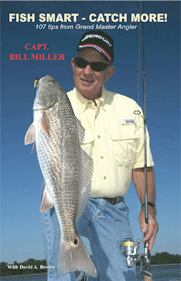Hot Tips
TALC TACKLES MOISTUREGetting your equipment wet is just part of fishing. But water, especially saltwater, can ruin your gear if you don’t minimize its effects. Most anglers know to rinse and dry their rods, reels and larger items. However, tossing wet plugs, hooks, sinkers, etc. back into your tackle box gives moisture plenty of time to attack. The key to avoiding this hidden destruction is to simply sprinkle a little talcum powder into your tackle containers, give it a little shake and let the dry granules absorb any moisture left inside. And don’t forget smaller containers like Ziploc bags for wire rigs, or film canisters for small hooks, swivels and sinkers. A little shake of powder will keep your tackle ready for action. THEFT PREVENTIONLive shrimp is probably the all-time best bait for general inshore fishing. Everything in the water eats these tasty crustaceans – and that includes the pesky pinfish. If you leave a hooked shrimp in one place for too long, you’ll almost always attract a horde of pinfish, which will peck away at your bait until it’s nearly useless. Casting and retrieving is one option, but if you need to make a targeted presentation to, say a pothole or oyster bar drop-off, you’ll want to keep the bait in the strike zone. The key to this is floating your live shrimp under a cork. Set the depth appropriately for a bottom or mid-depth presentation and give the cork a little tug every few seconds. This hops the shrimp and spooks away the pinfish. If all goes well, you’ll keep the bait stealers at bay long enough for a bigger fish to find your bait. IT’S A DRAGWhen high winds and strong tides get the water running at a fast pace, inshore jigging can be tough because conditions create a lot of slack in your line. Most fish hit jigs when they’re falling, so the unwanted slack makes it hard for you to set the hook and easy for them to shake off. But you can overcome the condition by working with them. Just cast upwind (or uptide) and let your jig move along with the rolling water. All you have to do is reel steadily to keep up the slack. You’ll actually be trolling the jig rather than hopping it, so fish will have to commit to grabbing it on the run – and that usually means a solid hookup. HIGH-SPEED HOOKUPSDrifting or slow trolling live sardines is a good way to connect with Spanish mackerel over nearshore reefs and rock piles. This aggressive fish strikes with such speed and ferocity that it often hooks itself, but anglers can cut the action short by responding too quickly. Jerking the rod to set the hook on a mackerel is not only unnecessary, it’s counterproductive. If you have a steady hand and steely nerves, you can hold the rod while fishing and feel the fish strike, but don’t react until he draws the line tight and puts a bend in the rod. If you can’t seem to hook up this way, leave the rod in the rod holder. On the strike, the boat’s steady motion will apply consistent pressure that leads to a solid connection. |
||
|
||

































